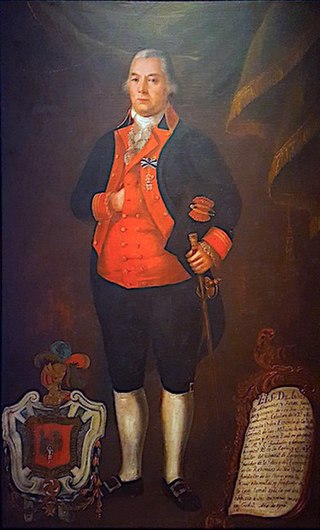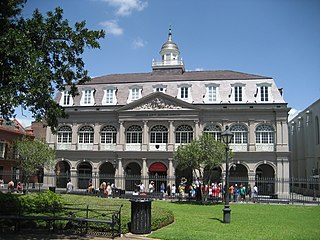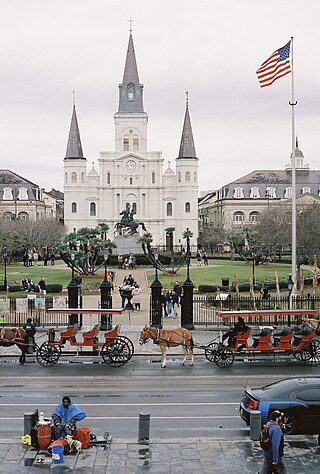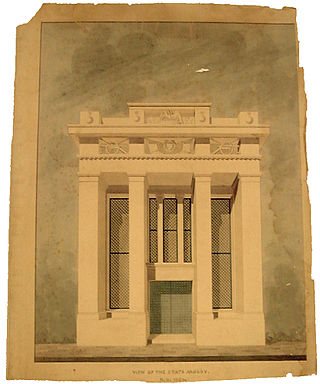
The French Quarter, also known as the Vieux Carré, is the oldest neighborhood in the city of New Orleans. After New Orleans was founded in 1718 by Jean-Baptiste Le Moyne de Bienville, the city developed around the Vieux Carré, a central square. The district is more commonly called the French Quarter today, or simply "The Quarter", related to changes in the city with American immigration after the 1803 Louisiana Purchase. Most of the extant historic buildings were constructed either in the late 18th century, during the city's period of Spanish rule, or were built during the first half of the 19th century, after U.S. purchase and statehood.

The Cathedral-Basilica of Saint Louis, King of France, also called St. Louis Cathedral, is the seat of the Roman Catholic Archdiocese of New Orleans and is the oldest cathedral in continuous use in the United States alongside the Royal Presidio Chapel in Monterey, California. It is dedicated to Saint Louis, also known as King Louis IX of France. The first church on the site was built in 1718; the third, under the Spanish rule, built in 1789, was raised to cathedral rank in 1793. The second St. Louis Cathedral was burned during the great fire of 1788 and was expanded and largely rebuilt and completed in the 1850s, with little of the 1789 structure remaining.

The New Orleans Mint operated in New Orleans, Louisiana, as a branch mint of the United States Mint from 1838 to 1861 and from 1879 to 1909. During its years of operation, it produced over 427 million gold and silver coins of nearly every American denomination, with a total face value of over US$ 307 million. It was closed during most of the American Civil War and Reconstruction.
Versailles is an unincorporated community in St. Bernard Parish, Louisiana, United States. It is located along the East Bank of the Mississippi River, approximately 3.5 miles below the lower limit of New Orleans. The community, for governmental and postal address purposes, is considered part of Chalmette and by some designations, part of neighboring Meraux. As a place designation, the name "Versailles" continues in local use.

DonAndrés Almonaster y Roxas de Estrada was a Spanish civil servant and philanthropist of New Orleans, today chiefly remembered for his numerous charitable benefactions made to the city of New Orleans.

The Cabildo, originally called "Casa Capitular", is a historical building in New Orleans, Louisiana. Originally the seat of Spanish colonial city hall, the building now forms part of the Louisiana State Museum. It is located along Jackson Square, adjacent to St. Louis Cathedral.

The Louisiana State Museum (LSM), founded in New Orleans in 1906, is a statewide system of National Historic Landmarks and modern structures across Louisiana, housing thousands of artifacts and works of art reflecting Louisiana's legacy of historic events and cultural diversity.

Jackson Square, formerly the Place d'Armes (French) or Plaza de Armas (Spanish), is a historic park in the French Quarter of New Orleans, Louisiana. It was declared a National Historic Landmark in 1960, for its central role in the city's history, and as the site where in 1803 Louisiana was made United States territory pursuant to the Louisiana Purchase. In 2012 the American Planning Association designated Jackson Square as one of the Great Public Spaces in the United States.

James Gallier was a prominent nineteenth-century Irish-born American architect, most famed for his buildings in New Orleans. Gallier Hall, which he designed and once served as New Orleans City Hall, is named after him.

The Great New Orleans Fire (1788) was a fire that destroyed 856 of the 1,100 structures in New Orleans, Louisiana, on March 21, 1788, spanning the south central Vieux Carré from Burgundy to Chartres Street, almost to the Mississippi River front buildings. An additional 212 buildings were destroyed in a later citywide fire, on December 8, 1794.

The Great New Orleans Fire (1794) was a major fire that destroyed 212 structures in New Orleans, Louisiana on December 8, 1794, in the area now known as the French Quarter from Burgundy to Chartres Street, adjacent to the Mississippi River. On March 12, 1788, just 6 years prior, 856 buildings had been destroyed in the First Great New Orleans Fire.

The Presbytère is an architecturally important building in the French Quarter of New Orleans, Louisiana. It stands facing Jackson Square, adjacent to the St. Louis Cathedral. Built in 1813 as a matching structure for the Cabildo, which flanks the cathedral on the other side, it is one of the nation's best examples of formal colonial Spanish architecture. It was designated a National Historic Landmark in 1970, and is now a property of the Louisiana State Museum.

The buildings and architecture of New Orleans reflect its history and multicultural heritage, from Creole cottages to historic mansions on St. Charles Avenue, from the balconies of the French Quarter to an Egyptian Revival U.S. Customs building and a rare example of a Moorish revival church.

The Pontalba Buildings form two sides of Jackson Square in the French Quarter of New Orleans, Louisiana. They are matching red-brick, one-block-long, four‑story buildings built between 1849–1851 by the Baroness Micaela Almonester Pontalba. The ground floors house shops and restaurants; and the upper floors are apartments which, reputedly, are the oldest continuously-rented such apartments in the United States.

Micaela Leonarda Antonia de Almonester Rojas y de la Ronde, Baroness de Pontalba was a wealthy New Orleans-born Creole aristocrat, businesswoman, and real estate designer and developer, who endures as one of the most recalled and dynamic personalities in the city's history, though she lived most of her life in Paris.

Ashland Plantation, also known as the Belle Helene or Ashland-Belle Helene Plantation, is a historic building, built in 1841, that was a plantation estate and home of Duncan Farrar Kenner. Located in Darrow, Louisiana, in Ascension Parish. The manor house is an example of antebellum Greek Revival architecture.

Ignace François Broutin was a French Chevalier of the Order of St. Louis military officer, commander of Fort Rosalie among the Natchez people, and later an architect and Captain of Engineers of the King in the Province in colonial Louisiana. He is chiefly remembered for designing the Ursuline Convent, completed by 1753 and the oldest and only surviving French colonial building in New Orleans.

The Old Louisiana State Armory, commonly referred to as the Arsenal, faces St. Peter Street in the French Quarter only a few yards from historic Jackson Square in New Orleans, Louisiana. Since 1914 it has served as a Louisiana State Museum site; it is open to the public via the adjacent Cabildo museum.

Pontalba is an opera in two acts composed by Thea Musgrave. Musgrave also wrote the libretto which is loosely based on the life of Micaela Almonester, Baroness de Pontalba, a prominent figure in 19th-century New Orleans. The opera was commissioned by New Orleans Opera to celebrate the two hundredth anniversary of the Louisiana Purchase. It premiered on 2 October 2003 at the Mahalia Jackson Theater in New Orleans conducted by Robert Lyall with Yali-Marie Williams in the title role.

In New Orleans, a gallery is a wide platform projecting from the wall of a building supported by posts or columns. Galleries are typically made of cast iron with ornate balusters, posts, and brackets.




















